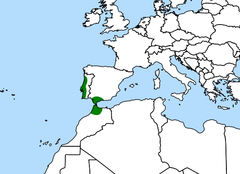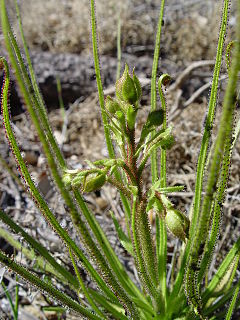- Drosophyllum
-
Drosophyllum Drosophyllum lusitanicum in the wild. Scientific classification Kingdom: Plantae (unranked): Angiosperms (unranked): Eudicots (unranked): Core eudicots Order: Caryophyllales Family: Drosophyllaceae
Chrtek, Slaviková & Studnicka (1989)Genus: Drosophyllum
LinkSpecies: D. lusitanicum Binomial name Drosophyllum lusitanicum
(L.) Link
Drosophyllum distribution Synonyms - Drosera lusitanica
L. - Drosophyllum pedatum
Dutailly nom.nud. - Rorella lusitanica
(L.) Raf. - Spergulus droseroides
Brot. ex Steud. nom.illeg.
Drosophyllum (
 /ˌdrɒsɵˈfɪləm/, rarely /drəˈsɒfɪləm/) is a genus of carnivorous plants containing the single species Drosophyllum lusitanicum (Portuguese Sundew or Dewy pine). In appearance, it is similar to the related genus Drosera (the sundews), and to the much more distantly related Byblis (the rainbow plants).
/ˌdrɒsɵˈfɪləm/, rarely /drəˈsɒfɪləm/) is a genus of carnivorous plants containing the single species Drosophyllum lusitanicum (Portuguese Sundew or Dewy pine). In appearance, it is similar to the related genus Drosera (the sundews), and to the much more distantly related Byblis (the rainbow plants). An illustration of the mucilagenous glands by Darwin
An illustration of the mucilagenous glands by Darwin
Drosophyllum lusitanicum is native to the western Mediterranean region (Portugal, Spain and Morocco), and is one of the few carnivorous plants to grow in dry, alkaline soils. The 20–40 cm (7.9–16 in) glandular leaves, which uncoil from a central rosette, lack the power of movement common to most sundews, but have the unusual characteristic of being coiled outward when immature. The plant has a distinct sweet aroma, which attracts the insects it preys upon. When insects land on the leaves, they find themselves stuck to the mucilage secreted by the stalked glands on the leaves. The more the insects struggle, the more ensnared they become, ultimately dying of suffocation or exhaustion. The plant then secretes enzymes which dissolve the insects and release the nutrients which are then absorbed by the plant. The plant uses these nutrients to supplement the nutrient-poor soil it grows in.
Drosophyllum lusitanicum bears bright yellow flowers that are 4 cm (1.6 in) in diameter and are born in groups of 3-15 between February and May. The translucent seedpods bear 3-10 opaque black pear-shaped seeds, 2.5 mm (0.098 in) in diameter. Seed germination may be aided by scarification.
The genus had always been assumed to be closely allied to Drosera and was previously placed in the Droseraceae. Recent molecular and biochemical studies, however, place it in the monotypic Drosophyllaceae (Chrtek, Slaviková & Studnicka), as recommended by the Angiosperm Phylogeny Group, and allied with the Dioncophyllaceae (Triphyophyllum) and Ancistrocladaceae.
Classification
The APG system (1998) and APG II system (2003) assigns Drosophyllaceae to the order Caryophyllales in the clade core eudicots. D. lusitanicum had previously always been included in the family Droseraceae, as it catches insects with a method reminiscent of that used by many plants in that family.
Recent molecular and biochemical evidence (see the AP-Website) suggests that the carnivorous taxa in the order Caryophyllales (the families Droseraceae, Drosophyllaceae, Nepenthaceae, and the species Triphyophyllum peltatum) all belong to the same clade which does not consist only of carnivorous plants but also includes some non-carnivorous plants such as those in the family Ancistrocladaceae.
External links
- International carnivorous plant society
- A detailed look at Drosophyllum
- Botanical Society of America, Drosophyllum lusitanicum Link.
Carnivorous plants (list) Genera Aldrovanda • Brocchinia • Byblis • Catopsis • Cephalotus • Darlingtonia • Dionaea • Drosera • Drosophyllum • Genlisea • Heliamphora • Nepenthes • Philcoxia • Pinguicula • Roridula • Sarracenia • Triphyophyllum • UtriculariaProtocarnivorous Aracamunia • Capsella • Colura • Dipsacus • Drymocallis • Geranium • Ibicella • Lathraea • Paepalanthus • Passiflora • Plumbago • Proboscidea • StylidiumExtinct Archaeamphora • Droserapites • Droserapollis • Droseridites • Fischeripollis • Palaeoaldrovanda • SaxonipollisSee also Categories:- Carnivorous plants of Africa
- Carnivorous plants of Europe
- Caryophyllales
- Monotypic plant genera
- Flora of Morocco
- Flora of Portugal
- Flora of Spain
- Drosera lusitanica
Wikimedia Foundation. 2010.



